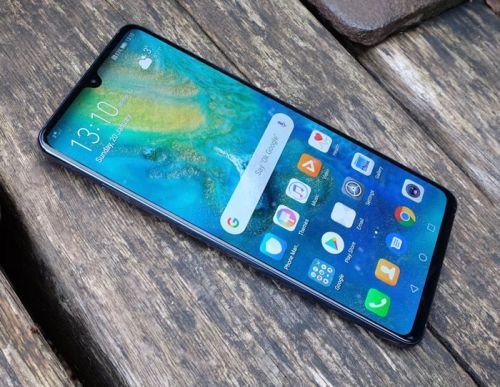Late last year, Huawei released one of the best phones of 2018 in the Huawei Mate 20 Pro. We were extremely impressed with its design, performance, and camera smarts.
But it wasn’t the only member of the Mate 20 family. The Huawei Mate 20 provides a compelling entry to the increasingly competitive £500 ‘cheap flagship’ category, while the Huawei Mate 20 Lite is a decent mid-range option from a little further down the price spectrum.
Now there’s a fourth member of the Mate 20 family in the Huawei Mate 20 X. It’s arguably the most interesting offering of the lot, though it’s decidedly not for everyone.
This is a phone that’s pitched at the “ambitious gamers and entertainment bingers” out there, with one particularly noteworthy component.
Screen
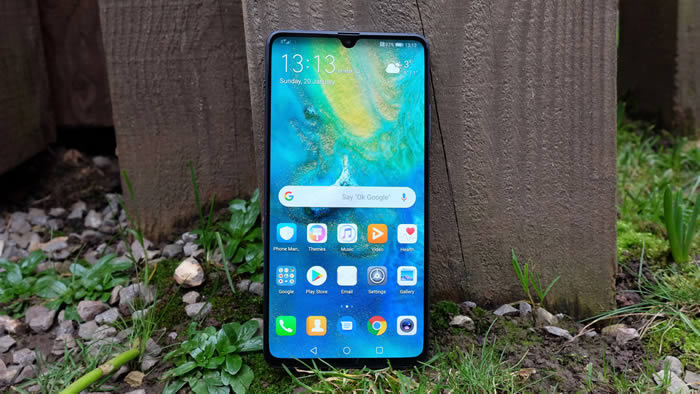
Let’s get the obvious comment out of the way: the Huawei Mate 20 X’s display is huge. At 7.2-inches, it’s the kind of screen size that used to be the preserve of compact tablets. It positively dwarfs the 6.39-inch display of the Huawei Mate 20 Pro, which was hardly small itself.
Conversely, the Mate 20 X’s screen isn’t as sharp as its Pro bro’s. At 1080 x 2244, it’s equivalent to Full HD rather than QHD.
It’s debatable whether QHD resolutions are necessary in most smartphones, but if ever there was a screen that would benefit from the extra pixels it’s this 7.2-inch beast. As it is, a pixel density of 346ppi isn’t too hot, especially in a phone that will set you back the best part of £800.
Not that we particularly noticed this lack of sharpness during our time with the phone. Everything from web pages to photos, games to YouTube videos looks great. You’d need to hold it next to one of those aforementioned QHD screens to notice any kind of pixel shortfall.
Huawei has gone with AMOLED over LCD technology, which means that colours really pop and blacks are deep and true. It doesn’t have that ridiculously oversaturated tone that AMOLED panels used to have, but even if you do find it a little gaudy it’s possible to tone things down in the settings menu.
Design
The Huawei Mate 20 X’s huge 7.2-inch display has a considerable knock on effect when it comes to the size and usability of the phone.
At 174.6mm tall and 85.4mm wide, this is a very big phone indeed. The notoriously large iPhone XS Max is a mere slip of a thing by comparison at ‘just’ 157.5mm x 77.4mm. If you’re someone who wears tight-fitting jeans, the Huawei Mate 20 X isn’t going to slip into any of the pockets without a fight.
One other consequence of the Mate 20 X’s huge display is the need for a huge battery. We’ll discuss what this means for stamina a little later, but in design terms this means that the phone is rather heavy. At 232g it’s 24g heavier than the aforementioned iPhone XS Max and 43g heavier than the Huawei Mate 20 Pro.
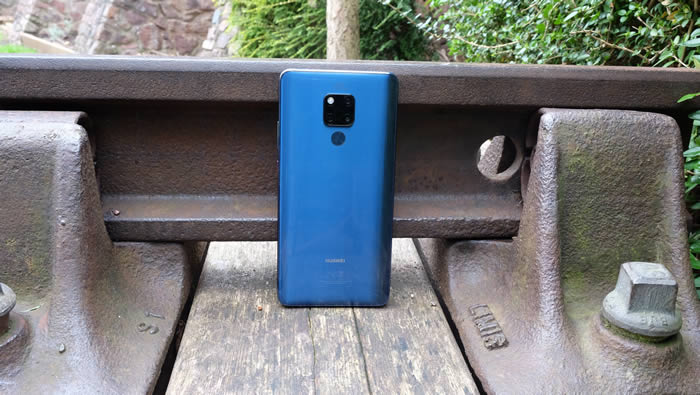
Unwieldiness aside, the Huawei Mate 20 X is a handsomely built device. It adopts a similar design language to its Mate 20 Pro and Mate 20 brothers, with glass on the front and back and a metal edge. There’s a curiously textured finish to the rear panel that makes it a lot grippier than your average glass phone.
Like the other phones in the family, Huawei has reduced the bezels and spread the display out to the far corners, with a screen notch accounting for the front camera. The latter is a subtle teardrop shape akin to the Huawei Mate 20 and the OnePlus 6T rather than the drawn-out bar of the Huawei Mate 20 Pro and the iPhone XS.
Power
When it arrived, the Huawei Mate 20 Pro was pretty much the most powerful Android device on the market. The only phone that has matched it since is the plain Huawei Mate 20, which packs the same speedy Kirin 980 CPU but with a less demanding display resolution.
That latter combination is something the Huawei Mate 20 X mirrors. The Kirin 980 is a seriously capable piece of silicon which is made using an advanced 7nm process. This enables it to be faster and more efficient than the Snapdragon 845 that powers most of its flagship rivals.
It also packs a healthy 6GB of RAM. This ensures that apps and web pages can be kept open and flicked between without pause, and there’s a general sense of swiftness when browsing through the phone’s menus.
High-end games like Asphalt 9 and PUBG positively fly on the Mate 20 X, while simpler fare like Super Mario Run really benefits from being scaled up to 7.2-inches.
The first 2019 flagships will be along over the coming months, which will almost certain outstrip the Mate 20 X for performance. But right now, only the iPhone XS family of devices can beat the Huawei Mate 20 X for raw power.
Camera
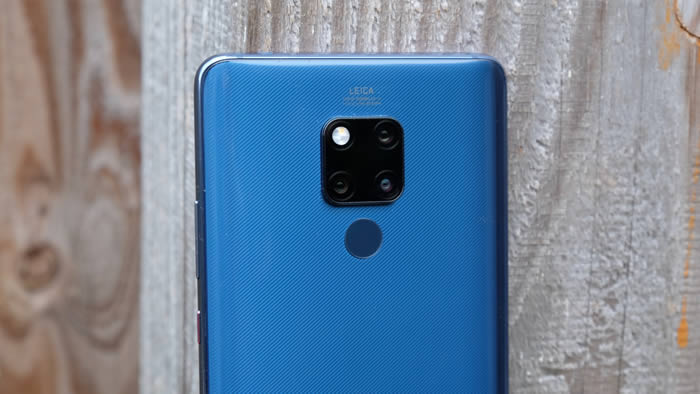
The Huawei Mate 20 Pro’s triple camera was arguably its most impressive component, and the Huawei Mate 20 X offers a similarly comprehensive photographic package.
Once again, you get a Leica-branded combination of a 40-megapixel wide-angle lens, a 20-megapixel ultra wide-angle one and an 8-megapixel telephoto one. At its most basic, this enables three distinct physical zoom levels.
But it also works to capture additional depth information for pronounced portrait shots. There’s also a Master AI mode that can be toggled on, which reads the scene you’re shooting and makes enhancements accordingly. This generally works well, though it can occasionally overplay its hand with some unnatural-looking shots.
You also get a night mode that pulls out much cleaner and clearer pictures in less than ideal lighting than you might be expecting.
There’s a 24-megapixel for selfies, with the usual bunch of gimmicky lighting features and skin-smoothing algorithms that you’ll probably want to ignore. But really it’s all about that accomplished rear camera module, which continues to impress in the X.
Features
Given that the Huawei Mate 20 X is all about enhanced media playback, it’s good to see that stereo speakers have made their way into the package. They’re two distinct speakers as well, positioned to one side of the top and bottom edges.
Some phones fudge the issue somewhat by making the earpiece double as one of these speakers, but there’s none of that nonsense here. All we would say is that you’ll want to hold the phone with the notch on the right in landscape so that you don’t cover the speakers.
Though we prefer the subtle look of the Mate 20 X’s teardrop screen notch over the Mate 20 Pro’s, it does make for a less sophisticated - and thus less secure - facial ID system. You might want to stick with the classic fingerprint sensor.
Speaking of which, there’s no in-display fingerprint sensor here like you get with the Mate 20 Pro. You’ll have to do things the old fashioned way with a rear-mounted example. It’s a little hard to locate at first thanks to the sheer size of the handset, but it’s fast and reliable.
There’s a familiar caveat with every Huawei phone, and that’s the company’s custom EMUI software. It might be layered over Android 9 Pie, which is Google’s latest OS, but it still feels a little dated.
EMUI 9 is somewhat clunky and gaudy compared to stock Android, as well as many rival custom UIs. There are too many duplicate or superfluous apps preinstalled too.
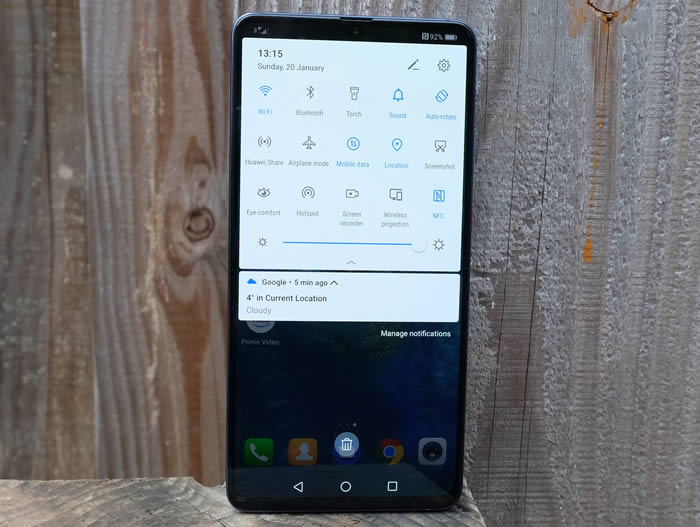
But as ever with Android, it’s possible to mitigate this through judicious use of the Google Play Store and the innate customisability of Google’s mobile OS.
Battery life, memory and connectivity
As already mentioned, the Huawei Mate 20 X backs its massive display with an equally huge battery. At 5,000mAh, it’s really tipping the scales. We thought the Mate 20 Pro’s 4,200mAh unit was big.
The result is yet another high-end Huawei phone that will last you two full days of moderate usage. That’s truly impressive.
It also means that the phone can stand up to the intensive tasks it’s been built for. Playing games and watching videos won’t put the same kind of dent in your battery life as on other phones, despite the presence of that huge screen.
Fast charging is supported, so you won’t have to wait hours for a full charge just because the battery is 50% bigger than its rivals.
There’s ample storage for all that media you’ll be consuming, too. With 128GB as standard and a nano memory card slot for adding up to 256GB extra, there’s plenty to go around.
When it comes to connectivity, the Mate 20 X supports 4G, Bluetooth 5.0 and NFC. You also get dual-SIM support, though you won’t be able to use a second SIM if you have a nano memory card inserted (and vice-versa).
Verdict
The Huawei Mate 20 X is a powerful phone with a spectacularly large display and exemplary battery life, making it a serious option for avid gamers and mobile Netflix bingers. It also packs a brilliant triple camera system.
However, its bloated form factor means that it’s not an easy phone to lug around with you on a daily basis, while Huawei’s custom UI can’t quite match the polished feel of its hardware.
This is a phone with niche appeal, and the Huawei Mate 20 Pro remains a better buy overall. But for those who like their phablets to go heavy on the ‘tablet’ part of the equation, the Mate 20 X is an intriguing option.


